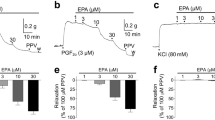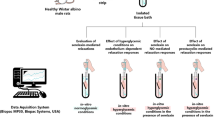Abstract
PROSTAGLANDIN E1 (9-keto, 11α, 15, dihydroxy-prost-13-enoic acid, PGE1) was the first of several prostaglandins to be isolated by Bergström et al.1,2. It is a member of a chemically new group of vasodilator substances. Other naturally occurring vasodilators such as bradykinin, acetylcholine and histamine have effects on several types of tissue in addition to smooth muscle. For example, bradykinin increases capillary permeability, produces pain on application to a blister base and releases adrenaline from the adrenal medulla3,4. The actions of PGE1 on these and other biological preparations have been investigated using bradykinin as a standard for comparison. The results are summarized in Table 1.
This is a preview of subscription content, access via your institution
Access options
Subscribe to this journal
Receive 51 print issues and online access
$199.00 per year
only $3.90 per issue
Buy this article
- Purchase on Springer Link
- Instant access to full article PDF
Prices may be subject to local taxes which are calculated during checkout
Similar content being viewed by others
References
Bergström, S., and Sjoväll, J., Acta Chem. Scand., 14, 1701 (1960).
Bergström, S., and Samuelsson, B., J. Biol. Chem., 237, 3005 (1962).
Elliott, D. F., Horton, E. W., and Lewis, G. P., J. Physiol. (Lond.), 153, 473 (1960).
Feldberg, W., and Lewis, G. P., J. Physiol. (Lond.), 167, 46, P (1963).
Author information
Authors and Affiliations
Rights and permissions
About this article
Cite this article
HORTON, E. Action of Prostaglandin E1 on Tissues which respond to Bradykinin. Nature 200, 892–893 (1963). https://doi.org/10.1038/200892b0
Issue Date:
DOI: https://doi.org/10.1038/200892b0
This article is cited by
-
Laser phototherapy in the treatment of periodontal disease. A review
Lasers in Medical Science (2010)
-
Characterization of prostanoid receptor‐evoked responses in rat sensory neurones
British Journal of Pharmacology (1998)
-
Effects of prostaglandins and other putative chemical intermediaries on the activity of canine testicular polymodal receptors studied in vitro
Pfl�gers Archiv European Journal of Physiology (1987)
-
The bradykinin-induced coronary vasodilation. evidence for an additional prostacyclin-independent mechanism
Naunyn-Schmiedeberg's Archives of Pharmacology (1979)
Comments
By submitting a comment you agree to abide by our Terms and Community Guidelines. If you find something abusive or that does not comply with our terms or guidelines please flag it as inappropriate.



